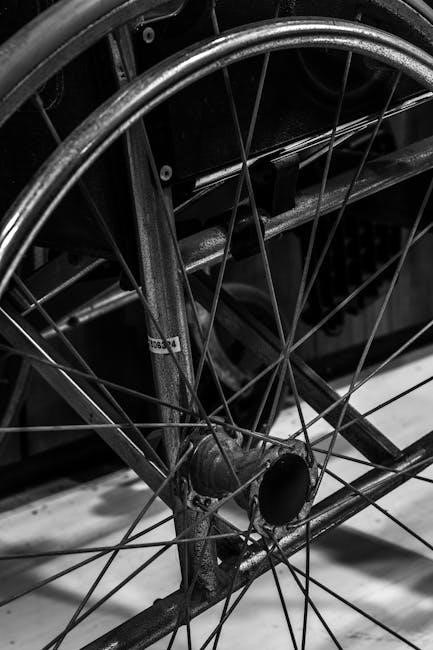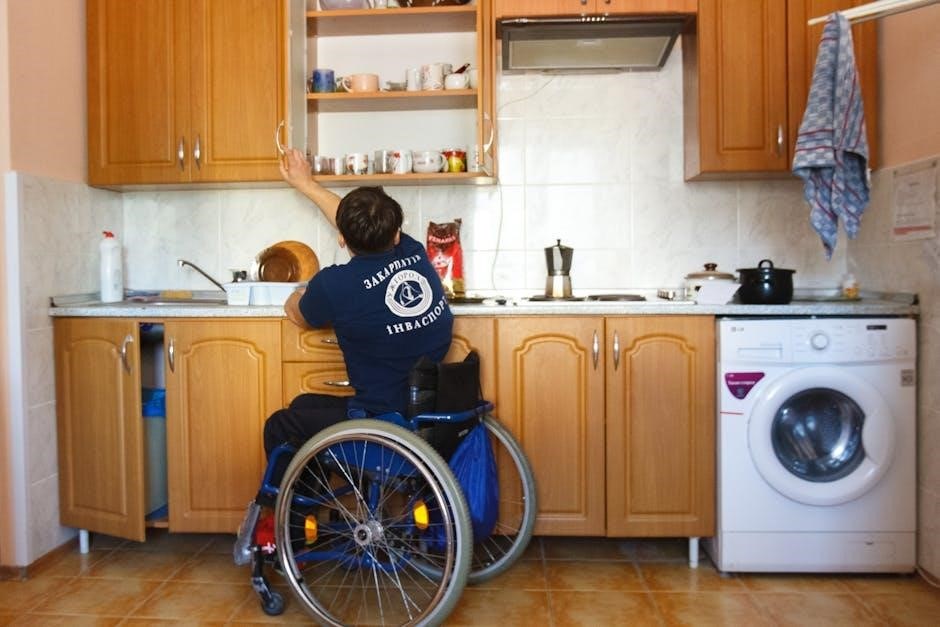
Welcome to the Medline Wheelchair Manual, your essential guide for safe and effective use of your mobility aid. This manual covers key features, safety precautions, assembly, maintenance, and troubleshooting to ensure optimal performance and user satisfaction. Whether you’re a first-time user or seeking to customize your chair, this resource helps you navigate every aspect of your Medline wheelchair experience.
1.1 Overview of the Medline Wheelchair
The Medline wheelchair is a high-quality mobility solution designed for comfort, durability, and ease of use. It features a lightweight yet sturdy frame, adjustable components, and tool-free designs for convenience. Models like the Excel K4 Lightweight Wheelchair offer advanced features such as quick-release axles and anti-tip attachments for enhanced safety. With options for pediatric, bariatric, and transport chairs, Medline caters to diverse needs, ensuring reliable mobility for users with varying requirements. Its design prioritizes user safety and versatility for both indoor and outdoor use.
1.2 Importance of the User Manual
The user manual is essential for understanding your Medline wheelchair’s features, safety guidelines, and proper usage. It provides detailed instructions for assembly, maintenance, and troubleshooting, ensuring optimal performance and longevity. By following the manual, users can customize settings to their needs and avoid potential hazards. Additionally, it outlines warranty information and maintenance tips, helping users maintain their wheelchair’s condition. Adhering to the manual ensures safety, extends the product’s lifespan, and maximizes user satisfaction.

Key Features of Medline Manual Wheelchairs
- Lightweight and durable design for easy maneuverability.
- Adjustable seats and armrests for personalized comfort.
- Tool-free wheel removal for convenient transport.
- Anti-tip attachments for enhanced stability and safety.
These features ensure a seamless and secure user experience.
2.1 Lightweight and Durable Design
The Medline manual wheelchair is crafted with a lightweight yet durable aluminum frame, ensuring easy maneuverability and longevity. Weighing just 33 lbs, it offers optimal portability while maintaining a sturdy structure. The design prioritizes user comfort and mobility, with a weight capacity of up to 300 lbs. Its tool-free wheel removal feature enhances convenience for transport, and anti-tip attachments provide added safety. This balance of strength and portability makes it an ideal choice for daily use, both indoors and outdoors.
2.2 Adjustable Seat and Armrests
The Medline wheelchair features an adjustable seat and armrests, allowing users to customize their fit for optimal comfort and support. The swing-back armrests facilitate easy transfers and can be adjusted to suit individual preferences. This adaptability ensures a secure and comfortable seating position, promoting proper posture and reducing fatigue. The adjustable design caters to various user needs, making the wheelchair versatile for different body types and mobility requirements, while maintaining durability and ease of use.
2.3 Tool-Free Removal of Wheels
The Medline wheelchair offers a convenient tool-free removal system for its wheels, enhancing portability and storage. This feature allows users to quickly detach the wheels without additional tools, making transportation easier. The quick-release axles ensure a secure fit when the wheels are in place and simplify maintenance. This design improves overall accessibility and user independence, catering to individuals who need a lightweight and easy-to-handle mobility solution. The tool-free mechanism is a practical innovation that streamlines daily use and travel.
2.4 Anti-Tip Attachments for Safety
Medline wheelchairs come equipped with anti-tip attachments, designed to enhance stability and prevent the chair from tipping backward. These attachments provide additional safety, especially during transitions or on uneven surfaces. They ensure a secure experience, reducing the risk of accidents. The anti-tip feature is particularly beneficial for users who may have limited upper body strength or balance issues. This innovative addition underscores Medline’s commitment to user safety and confidence, making their wheelchairs a reliable choice for various mobility needs.

Safety Guidelines and Precautions
Safety is paramount when using your Medline wheelchair. Always engage wheel locks on inclines, avoid weight training, and follow weight capacity guidelines to ensure stability and prevent accidents.
3.1 General Safety Information
Always prioritize safety when using your Medline wheelchair. Engage wheel locks on inclines, avoid weight training, and ensure the chair is used as intended. Use anti-tip attachments to prevent tipping and follow weight capacity guidelines. Regularly inspect the chair for wear and tear. Adhere to all instructions and warnings in this manual to ensure safe operation and longevity of your Medline wheelchair. Proper usage and maintenance are key to preventing accidents and ensuring optimal performance.
3.2 Weight Capacity and Usage Restrictions
Adhere to the specified weight capacity of your Medline wheelchair to ensure safety and durability. Exceeding the maximum weight limit can compromise the chair’s structural integrity and lead to potential accidents. Avoid using the wheelchair for activities like weight training, as it is not designed for such purposes. Always follow the recommended usage guidelines to maintain optimal performance and extend the lifespan of your mobility aid. Consult the manual or a qualified technician for specific weight capacity details and usage recommendations.
3.3 Proper Use of Wheel Locks
Engage the wheel locks whenever you enter or exit the wheelchair, during transfers, or when stationary on an incline. Ensure both locks are securely activated to prevent unintended movement. Always test the locks before use to confirm they are functioning correctly; Failure to properly engage the locks can lead to accidents or instability. Regularly inspect the locking mechanism for wear and tear, and consult the manual for maintenance instructions to ensure continued reliability and safety.
3.4 Avoiding Weight Training with the Wheelchair
Never use your Medline wheelchair for weight training or any activity that involves excessive stress or strain. The wheelchair is designed solely for mobility assistance and has not been tested for weight-bearing exercises. Misusing it for such purposes can damage the frame, compromise safety, and void the warranty. Always adhere to the recommended usage guidelines provided in the manual to ensure the longevity and safe operation of your wheelchair.

Assembly and Setup
Proper assembly and setup of your Medline wheelchair ensure optimal performance and safety. Begin by unfolding the chair and securing it in the upright position. Adjust the seat depth and height to fit your body comfortably. Attach any accessories, such as armrests or footrests, according to the manufacturer’s instructions. Ensure all bolts and screws are tightened securely. For first-time users, refer to the diagrams provided in the manual for clarity. Always store the wheelchair in a dry, clean environment when not in use to maintain its condition.
4.1 Unfolding and Folding the Wheelchair
To unfold the wheelchair, stand behind it and pull the seat upholstery forward until the frame clicks into place. Ensure the chair is fully open and stable; For folding, locate the release handle under the seat and pull it upward while pushing the chair downward. Fold the wheelchair securely and store it in a dry, clean environment. Always ensure the chair is completely unfolded before use and folded correctly for storage to maintain its durability and functionality.
4.2 Adjusting Seat Depth and Height
Properly adjusting the seat depth and height ensures a comfortable and safe fit. To adjust the seat height, locate the release lever or knob under the seat and move it to your desired position. For seat depth, loosen the bolts on the side rails and slide the seat forward or backward. Tighten the bolts securely after adjustments. Ensure the chair is stable and on a level surface before making any changes. Always double-check the adjustments to confirm they meet your needs for optimal support and mobility. Regular adjustments may be necessary for continued comfort.
4.3 Attaching Accessories and Add-Ons
To enhance functionality and comfort, various accessories can be attached to your Medline wheelchair. Identify the designated attachment points, such as clips, brackets, or rails, on the frame. Secure accessories like armrests, footrests, or storage bags using the provided hardware. Ensure accessories are tightly fastened to avoid shifting during use. Refer to the specific accessory instructions for detailed steps. Properly installed add-ons help maintain the chair’s stability and performance. If unsure, consult a professional to ensure correct installation and safety.

Operating the Wheelchair
Ensure safe and effective use by following guidelines for propelling, navigating stairs, and using elevators. Always engage wheel locks when stationary or in elevators for stability.
5.1 Propelling the Wheelchair Manually
Propelling the Medline wheelchair manually requires proper technique to ensure comfort and efficiency. Grip the wheel rims firmly, avoiding the tires, and push backward to move forward. Use a smooth, consistent motion to maintain momentum. For tighter spaces, alternate pushing one wheel at a time. Always ensure the wheel locks are disengaged before moving. If assistance is needed, a companion can push the chair from behind using the handlebars. Regular practice will help master the technique and enhance mobility.
5.2 Navigating Stairs and Inclines
Navigating stairs and inclines with a Medline wheelchair requires caution and assistance. Always use elevators or ramps when possible, as stairs pose a significant safety risk. If stairs are unavoidable, ensure the wheelchair is facing upward when ascending and downward when descending. Engage the wheel locks and have a companion assist for stability. On inclines, maintain a slow and controlled pace, with the wheelchair facing uphill to prevent rolling backward. Always prioritize safety and seek alternative routes when possible.
5.3 Using the Wheelchair in Elevators
Always engage both wheel locks before entering or exiting an elevator. Position yourself facing forward, with your back against the elevator wall for stability. Ensure the elevator is large enough to accommodate your wheelchair comfortably. Avoid sudden movements and keep your hands on the armrests. If possible, have a companion assist you. Never lean forward or attempt to maneuver in a crowded elevator. Follow all safety guidelines to ensure a secure and smooth experience while using elevators with your Medline wheelchair.
5.4 Transporting the Wheelchair
Transporting your Medline wheelchair is straightforward when properly folded and secured. Always fold the chair according to the manual, ensuring wheels are removed if necessary. Use anti-tip attachments to prevent tilting during transport. Place the folded wheelchair in a secure, stable location, such as the trunk of a car or designated storage area. Ensure the chair is tightly fastened to avoid movement during transit. Regularly inspect the folding mechanism for wear to maintain reliability. Follow these steps to ensure safe and efficient transportation of your wheelchair.

Maintenance and Care
Regular maintenance ensures your Medline wheelchair remains in optimal condition. Clean the frame, wheels, and moving parts frequently. Lubricate hinges and axles periodically to prevent squeaks and wear. Inspect for damage or loose parts and address them promptly. Store the wheelchair in a dry, secure location when not in use to protect it from environmental damage. Proper care extends the lifespan and performance of your wheelchair.
6.1 Cleaning the Wheelchair
Regular cleaning is essential to maintain your Medline wheelchair’s performance and appearance. Use a mild soap solution and a soft, damp cloth to wipe down the frame, wheels, and casters. Avoid harsh chemicals or abrasive cleaners, as they may damage the finish or components. For fabric upholstery, use a gentle detergent and water, but avoid excessive moisture to prevent staining or mildew. Dry the chair thoroughly after cleaning to prevent rust or corrosion. Regular cleaning helps ensure your wheelchair remains in optimal condition for years of reliable use.
6.2 Lubricating Moving Parts
Lubricating the moving parts of your Medline wheelchair is crucial for smooth operation and longevity. Use a silicone-based spray lubricant on wheel axles, casters, and folding mechanisms. Apply a small amount to the moving components, then wipe off any excess with a clean cloth. Avoid lubricating brake systems or other non-moving parts. Regular lubrication prevents squeaks and ensures all parts function properly. Perform this maintenance every 3 months or when you notice squeaking or stiffness in the wheels or frame.
6.3 Inspecting for Wear and Tear
Regularly inspect your Medline wheelchair for wear and tear to ensure optimal performance. Check tires and wheels for signs of wear or damage. Examine the frame for any cracks or dents. Look for loose bolts or screws and tighten them as needed. Inspect the seat and backrest upholstery for tears or fraying. Also, check the brake pads and axles for excessive wear. Addressing these issues promptly helps maintain the wheelchair’s reliability and safety. If you find any damage, contact a qualified technician for repairs.
6.4 Storage Recommendations
Store your Medline wheelchair in a dry, cool place to prevent damage. Fold the chair if possible and keep it upright to save space. Avoid exposure to direct sunlight or moisture, as this can harm the tires and frame. Clean the wheelchair before storage to maintain its condition. Regularly inspect stored chairs for signs of wear or damage. Proper storage ensures your wheelchair remains in excellent condition for future use. Always follow the manufacturer’s guidelines for storage to extend the product’s lifespan.

Troubleshooting Common Issues
This section addresses common problems users may encounter, such as wheel alignment, brake malfunctions, and folding mechanism issues. Solutions are provided to restore functionality quickly and safely.
7.1 Wheel Alignment and Balance
Check wheel alignment by ensuring both wheels are parallel and evenly spaced. If misaligned, loosen axle bolts and adjust the wheels forward or backward. Tighten bolts securely after adjustment. For balance issues, inspect the frame and seat for levelness. If uneven, consult a technician to recalibrate. Proper alignment and balance are crucial for stability and smooth movement. Regular inspections can prevent these issues and ensure optimal wheelchair performance. Always refer to the manual for detailed guidance or contact a professional if problems persist.
7.2 Fixing a Squeaky Wheel
A squeaky wheel can be resolved by lubricating the axle and wheel bearings. Use a silicone-based spray or grease, applying it directly to moving parts. Wipe off excess with a cloth. If squeaking persists, check for loose connections and tighten any bolts. Ensure wheels are clean and free from debris. Regular lubrication prevents friction and noise. For persistent issues, contact a technician or Medline support. Proper maintenance ensures smooth and quiet operation of your wheelchair.
7.3 Addressing Brake Malfunctions
If your brakes are not functioning properly, ensure they are fully engaged and free from debris. Tighten any loose brake levers or cables. Lubricate moving parts with silicone spray if sticking occurs. If brakes fail to hold, inspect for worn brake pads or misaligned brake arms. Clean or replace worn components as needed. Always test brakes on a flat surface before use. For persistent issues, consult the user manual or contact Medline customer support to ensure safety and optimal performance.
7.4 Solving Folding Mechanism Problems
If the folding mechanism is not functioning smoothly, check for obstructions or debris. Ensure the seat back is in the upright position and the stabilizer bar is secure. Push the seat back firmly until the release assembly spring buttons click into place on both sides. If issues persist, refer to the user manual for detailed instructions or contact Medline customer support. Regular lubrication of moving parts can also prevent stiffness. Always ensure the chair is properly folded before storage to maintain its integrity and performance.

Frequently Asked Questions
Find answers to common questions about Medline wheelchairs, customization, maintenance, and troubleshooting; Refer to your user manual or contact Medline support for further assistance.
8.1 Can I Customize My Medline Wheelchair?
Yes, Medline wheelchairs offer customization options to meet individual needs; Users can choose from various models like the Excel K4 Lightweight Wheelchair, pediatric, bariatric, or transport chairs. Additional accessories, such as anti-tip attachments, can be added for enhanced safety. For further customization, contact Medline customer service or authorized dealers. Ensure adjustments align with the user manual guidelines to maintain safety and warranty validity.
8.2 How Do I Replace Wheels or Tires?
To replace wheels or tires on your Medline wheelchair, refer to the user manual for specific instructions. Most models, like the Excel K4, feature quick-release axles for tool-free wheel removal. Ensure the wheelchair is stationary and wheel locks are engaged before starting. Inspect the tires for wear and tear, and replace them if necessary. Always follow the manufacturer’s guidelines to maintain safety and warranty validity. If unsure, consult a qualified technician or contact Medline customer support for assistance.
8.3 Is the Wheelchair Suitable for Outdoor Use?
Medline wheelchairs are generally suitable for outdoor use, offering durability and stability on various surfaces. Models like the Excel K4 Lightweight Wheelchair are designed for versatility, with features like anti-tip attachments to enhance safety on uneven terrain. However, rough or steep inclines may require extra caution. Always engage wheel locks when stationary and ensure tires are in good condition for optimal performance. For added stability outdoors, consider using anti-tip attachments, which are available separately for select models. Regular maintenance and inspections are recommended to ensure reliability in outdoor settings.
8.4 What Warranty Options Are Available?
Medline wheelchairs typically come with a limited warranty covering manufacturing defects for a specified period. The Excel K4 Lightweight Wheelchair, for example, may include a five-year warranty on the frame. Wear and tear or misuse are generally not covered. For detailed warranty terms, refer to the user manual or contact Medline customer service. Proper maintenance and adherence to usage guidelines can help ensure warranty validity and extend the product’s lifespan.

Medline Wheelchair Models and Variants
Medline offers a diverse range of wheelchair models, including lightweight, standard, pediatric, bariatric, and transport variants, catering to different user needs and preferences for mobility support.
9.1 Excel K4 Lightweight Wheelchair
The Medline Excel K4 Lightweight Wheelchair is a popular choice, weighing only 33 lbs, designed for easy maneuverability and durability. Its quick-release axles allow tool-free wheel removal, while swing-back arms enhance accessibility. Built with a sturdy frame, this model supports users up to 300 lbs, offering both comfort and reliability. Ideal for self-propelled or assisted mobility, it features adjustable seating and a foldable design for convenient storage and transport. Perfect for everyday use, it ensures a smooth and efficient mobility experience.
9.2 Standard Manual Wheelchair Models
Medline’s standard manual wheelchairs are designed for durability and comfort, catering to users with mobility challenges. These models are ideal for individuals who require reliable, everyday mobility assistance. Built with sturdy frames, they offer adjustable features to accommodate various user needs. Suitable for both indoor and outdoor use, these wheelchairs provide a practical solution for those seeking a dependable mobility aid. Their straightforward design ensures ease of use, making them a popular choice for self-propelled or caregiver-assisted mobility.
9.3 Pediatric and Bariatric Options
Medline offers specialized wheelchairs for pediatric and bariatric users, ensuring comfort and support for diverse needs. Pediatric models are designed for growing children, with lightweight frames and adjustable features to accommodate growth. Bariatric options provide reinforced stability and higher weight capacities, ensuring safe and durable mobility for larger users. Both categories emphasize safety, with features like secure seat belts and sturdy construction; These models are tailored to meet the unique requirements of their users, promoting independence and confidence in daily mobility.
9.4 Transport Chair Variants
Medline transport chairs are designed for portability and convenience, offering lightweight and foldable options for easy transportation. These variants feature detachable wheels, compact frames, and comfortable seating, making them ideal for travel or short-distance use. Transport chairs are perfect for users who require assistance with mobility but do not need self-propulsion. They are easy to store and transport, ensuring versatility for various mobility needs. These models are a practical choice for users seeking reliable, on-the-go support.

Additional Resources and Support
Access comprehensive support and resources, including downloadable user manuals, contact details for customer service, authorized dealer locations, and active online communities for assistance and shared experiences.
10.1 Downloading the User Manual PDF
Easily access the Medline Wheelchair Manual in PDF format by visiting Medline’s official website or authorized dealer platforms. Navigate to the “Support” or “Resources” section, where you can search for your specific wheelchair model. Click the download link to save the manual, ensuring you have the latest version for accurate information. This PDF guide includes detailed instructions, safety tips, and troubleshooting advice to help you maximize your wheelchair’s performance and longevity. Always refer to the official source for the most reliable information.
10.2 Contacting Medline Customer Service
For assistance with your Medline wheelchair, contact Medline Customer Service directly via phone or email. Visit the official Medline website to find the contact information specific to your region. Ensure you have your wheelchair model number and a detailed description of your inquiry ready. Representatives are available to address questions, provide support, and guide you through troubleshooting or warranty-related matters. Always reach out through official channels to ensure accurate and reliable assistance tailored to your needs.
10;3 Finding Authorized Dealers
To purchase or service your Medline wheelchair, locate an authorized dealer through the official Medline website. Use the dealer locator tool by entering your location to find nearby retailers. Authorized dealers ensure genuine products, proper assembly, and adherence to warranty terms. They also offer expert advice and post-purchase support. Avoid unauthorized sellers to guarantee authenticity and safety. Contact Medline customer service if you need assistance finding a dealer in your area. This ensures you receive reliable and trustworthy service for your mobility needs.
10.4 Online Communities and Forums
Engage with online communities and forums to connect with other Medline wheelchair users, share experiences, and gain insights. Platforms like Medline’s official forum, social media groups, and independent disability forums offer valuable discussions. These spaces allow you to ask questions, receive advice, and stay updated on the latest products and accessories. Many users share tips on maintenance, customization, and troubleshooting. Participating in these communities can enhance your overall wheelchair experience and provide support from peers and experts. Visit Medline’s website for recommended forums and groups.